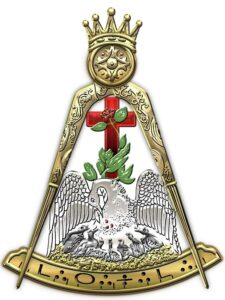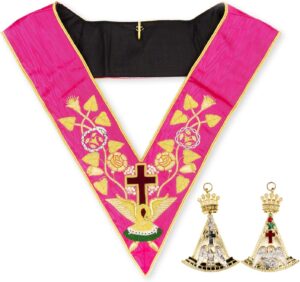Introduction to Rose Croix Masonry
What is this Order all about?
Let’s start at the top:
The ‘Rose Croix’ Degree is the 18th of a series of 33 Degrees, originating in France and which in 1801 were formed into the Ancient and Accepted Scottish Rite of Freemasonry. (A & A R). It now follows the Universality of Craft Masonry and allows members of all religions to join.

The Rose Croix ceremony (the ceremony of Perfection) is the only ceremony which can be worked in full by a Chapter. The first three degrees of Craft Masonry are accepted by The Supreme Council for England and Wales as the equivalents of the first three degrees of the A & A R and the intervening degrees from the 4º to the 17º (known as the Intermediate Degrees) are conferred by name – otherwise it may take months or even years to complete! The first 18º ritual originated with a Frenchman named Willermoz and is dated 1765. It has a wholly New Testament theme and is influenced by the legends of the descendants of the builders of the Temple at Jerusalem taking refuge in a mountain in Scotland called Heredom. When the Crusades began, the posterity of the masons joined the Crusades but on their return from the Holy Land dispersed and spread Masonry throughout the world. Several of the degrees of the A & A R include parts of this story.
The Rose Croix degree is first recorded as being worked in England in about 1770. The Knights Templar degrees were starting in England at about the same time and eventually the Rose Croix degree took its place as the final or ne plus ultra degree of the English Knights Templar encampments. After 1845 however Rose Croix Chapters gradually moved to their present position as the 18º of the A & A R.
The ceremony, which seeks the Perfection of moral virtues in Faith, Hope and Charity, is an immensely thought provoking, impressive and beautiful ceremony which instils a warmth of Brotherly love on which the whole Masonic movement is founded.
All degrees of the Rite from 4º – 33º are the entire responsibility of the Supreme Council. They were developed during the period 1730-1801; the majority before 1780. The 4º – 13º may be considered as extensions of the Master Masons legend referring to the completion of the Temple at Jerusalem under King Solomon’s direction. The 14º – 16º refer to the rebuilding of the Temple and were developed in France at about the same time and used the same material as the Royal Arch degree in England. The 17º is a mystical preparation for the 18º.
Between 1760 and 1780 the basic rituals of the 18º-25º were completed. Under the authority of the Grand Constitutions of 1786, signed by Frederick the Great, ruler of Prussia; in the last year of his reign the degrees were expanded to 33 to form the Ancient and Accepted Scottish Rite. Our Emblem, the Double Headed Eagle, which has thousands of years of history, emanates from there.
We are governed by The Supreme Council 33º for England Wales and its Districts and Chapters Overseas, which was Constituted in 1845 by the receipt of a Patent from the Northern Jurisdiction of the United States of America, which itself was Constituted in 1801, and is the governing body for what is properly called the Ancient and Accepted Rite in this country. It consists of 9 members and has been based at its headquarters at 10 Duke Street, St. James’ London since 1911. It is responsible for all matters pertaining to the Order within its jurisdiction including Ritual matters, Consecrations and conferring the Higher Degrees of the 30º – 33º during ceremonies which it carries out regularly at Convocations held at its headquarters, formally called the Grand East. The “Districts and Chapters Overseas” part of their title is very real and our Supreme Council governs the A&AR in large parts of the Caribbean and Africa; Supreme Council members visit Chapters in these territories regularly. Scotland and Ireland have their own Supreme Councils, the latter for all 32 counties, with which our own Supreme Council is in amity
In 1872 the Supreme Council decided to divide England and Wales into Districts under the direction of Inspectors General. They have certain powers delegated to them by Supreme Council and they can be assisted by a District Recorder. There is no District organization similar to that in the Craft, Royal Arch, Mark, Knights Templar, etc. The two of us are it!!
The District originally consisted of Buckinghamshire, Berkshire and Oxon. In 1997 the Inspector General, V Ill Brother Leslie Harborne 33º made the decision to split the District into three separate Districts. The District of Berkshire has nine Chapters, based in Abingdon, Newbury, Sindlesham, Wallingford and Windsor. Therefore, there is a Rose Croix Chapter within easy reach of most parts of the District.
The Order amplifies the teachings of Craft Masonry based on moral virtues of Faith, Hope and Charity.
Brethren wishing to join this beautiful Order will find that the emphasis is on members who maintain the quality, friendliness and warmth of the Order which has a very thought provoking ritual.
Candidates for the ‘Rose Croix Degree’ must:
(a) have been initiated in a Lodge under or recognised by the United Grand Lodge of England ,and
(b) have been a Master Mason for at least six months and be in good standing within the Craft.

It is unique, in that prior to Perfection, a candidate is awarded the Intermediate Degrees from the 4th to the 17th, each have their own ceremony but other than presentations by the KEV11 Rose Croix Chapter of Improvement they are conferred on candidates by name only.
Nowhere in the 18º is the Candidate asked to swear an oath: all the Obligations are promises. One may presume that the word of a man of the type invited to join the Degree once given, is ample bond.
Regalia for the 18th degree is both simple and spectacular and comprises a red collar embroidered in gold braid with symbols and emblems of the Degree of Perfection.
Brethren I sincerely hope that has given you a brief insight into this beautiful Order of ours and should anyone wish to learn more please do not hesitate to contact me.
David R Jarvis, 33o Inspector General, District of Berkshire
Email: ig33berkshire@gmail.com

